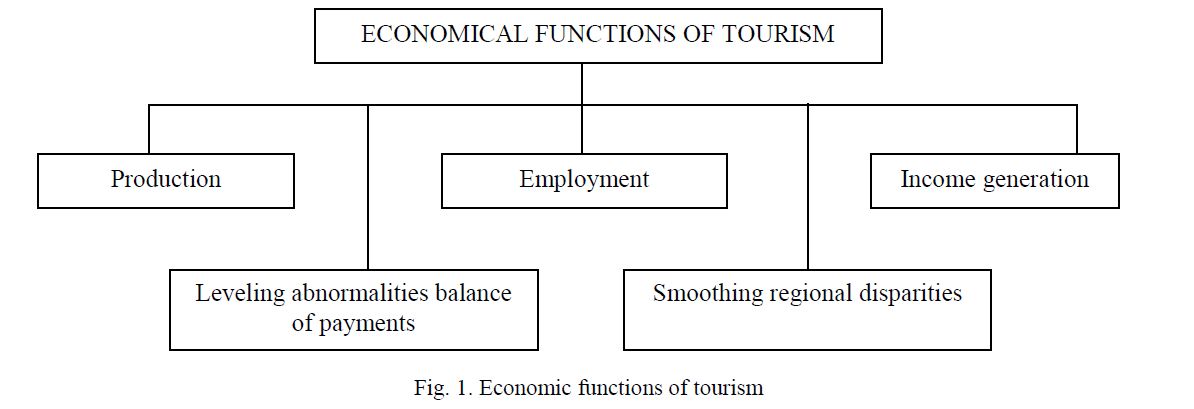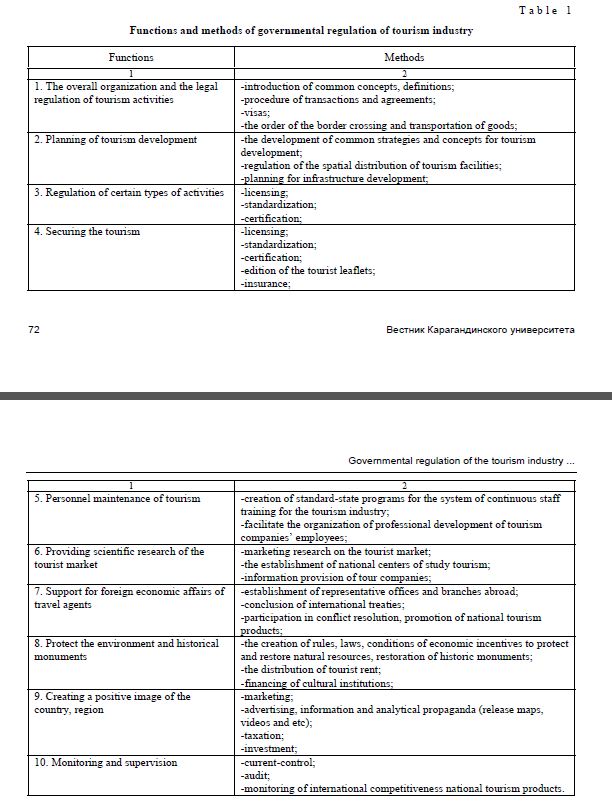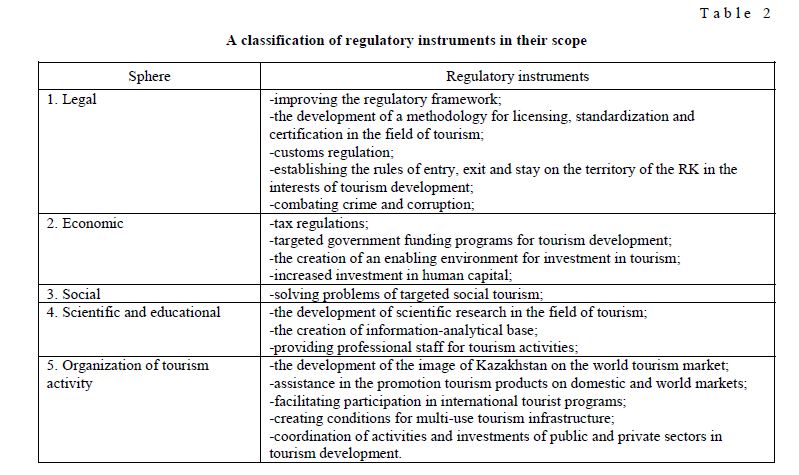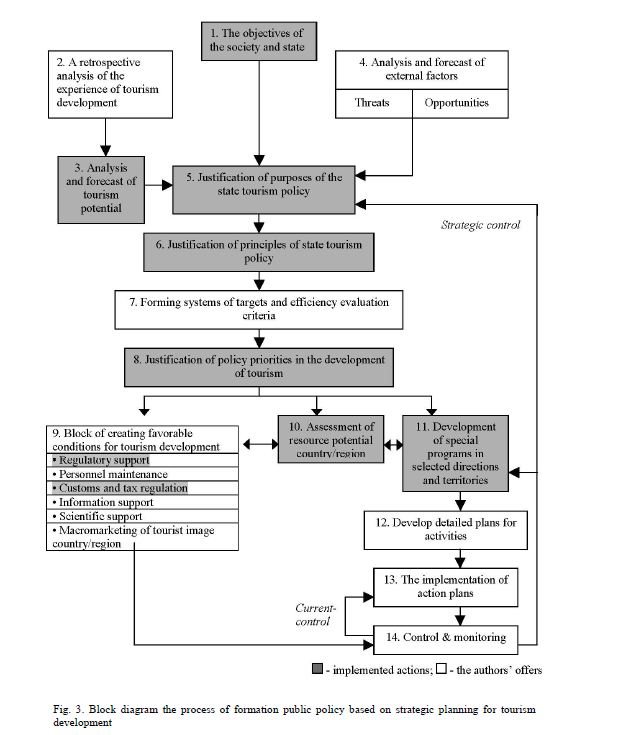Kazakhstan tourism industry’s development prospects are highly dependent on increase of governmental regulation of tourism sector on the national level, which must be combined with a modern promoting strategy of regional tourism products. Over the past decade has seen increased interest from the government to the tourism industry. This is confirmed by the following facts:
- adoption of the June 13, 2001 «Law on tourism activity»;
- decree of the President of the Republic of Kazakhstan of December 29, 2006 N 231 «On state program of tourism development in the Republic of Kazakhstan for 2007–2011»;
- the adoption of RK’s Government resolution dated June 25, 2005 «On approval of the creation and development of pilot clusters in priority sectors of the economy», in their number went tourism;
- increasing the size of investment in the tourism industry, for instance, from 25, 7 bn. tenge in 2007 to 63 billion tenge in 2008 [1].
Certainly, this is not an exhaustive list of measures taken by the government for tourism development.
However, despite this active government’s influence on the tourism industry many problems are remain unsolved. Effective development of tourism in Kazakhstan is largely hampered by the lack of clear governmental regulation of tourism industry, inadequate infrastructure and insufficient research of tourism from a scientific point of view. Analysis of the national literature and practice has shown no elaboration of the conceptual apparatus, the lack of a systematic approach and scientific methodology of justification the nature and extent of governmental regulation of tourism.
The absence of methodological framework and the lack of methodical development of the governmental regulation of the tourism industry problem provided relevance for the research.
Tourism as a socio-economic subsystem is interconnected with such institutions as the «economy», «society», ‘ecological environment». Life activity system of «tourism» is impossible without interaction with other sectors of the national economy. Therefore, substantiation of necessity of governmental regulation of tourism development based on the study of the current state of the tourism market, the analysis of the role of tourism in the economy, the characteristics of tourism consumption and specific tourism product, its impact on other sectors of the economy, in particular, on ecological condition and socio-cultural development of the country [2].
Traditionally, there are three economic functions in tourism: production, employment and income generation. We believe it is necessary to supplement the list of the economic functions of tourism with function of smoothing regional disparities, which is especially relevant today, and function of leveling abnormalities balance of payments. The implementation of these functions determines the place of tourism in national economy of the country [3]. The economic functions of tourism presented in Fig. 1.

Fig. 1. Economic functions of tourism
The scale and importance of tourism shows that it belonging to strategic sectors of the economy, which requires direct government regulation, to ensure the balanced development of regional and industry economic complexes, substantiation of employment policy, growth of budget revenues and control the balance of payments.
Multiple links of tourism with other sectors of the economy generate external economic, environmental and socio-cultural effects, the distribution of which is often beyond the control of the subjects of tourist activity. Therefore, governmental regulation of the tourism industry should focus on minimizing the negative and increase positive effects of external influences.
Regulation of the tourism industry is a multi-level system, comprising:
- coordination and promotion of tourism on a global scale, which is carried by the World Tourism Organization with the participation of international financial institutions;
- tourism policy coherence at the international level, which is achieved through the regional tourism organizations and specialized agencies of interstate associations (for example, the European Community);
- consistency of tourism policy on the national and regional levels, which is carried out through a specially created government authorities and public associations of tourism organizations [4].
Managing the market model with elements of governmental regulation of tourism development at national and regional levels, in an economic crisis of the early XXI century, is implemented through two main mechanisms: firstly, through the market self-regulation by achieving a balance of supply and demand, and secondly, through the introduction of certain mechanisms of public administration and coordination. In the second case the question is about the government regulation and self-organization of business entities as well through the creation of tourist unions and associations [5].
Governmental regulation of the tourism industry — it's impact of the state on economic entities and the market situation to ensure normal conditions of functioning of the market mechanism, the implementation of governmental socio-economical priorities and develop a unified concept of the tourism sector. This is a complex process that includes the procedure for the development of public policy of regulation tourism industry, substantiation its goals, objectives, main tendencies, selection of tools and methods for its implementation (Fig. 2).
Specific difference between the current market model with elements of governmental regulation of tourism industry from other sectors of the economy is that in the regulation of the industry involved community organizations, represented by tourism associations.
The content of government regulation of tourism industry is determined by the objective of the government authorities, as well as the tools available to the government in carrying out this policy. It should also be noted that in some countries, government policies in the tourism sector often does not stand out and integrated into other sectors of the economy, such as industrial policy, a policy of balance of payments, etc. However, this approach is inevitably lost the target orientation of regulation of tourism industry.
Government planning of the tourism industry is the basis for managing tourism. Domestic and international experience of public policy regulating the tourism industry indicates the need to address the problems of tourism in the overall context of the socio-economic development for several reasons.
Firstly, despite the relatively strong economic performance, tourist enterprises are an integral part of economic and social system of the region and the country as a whole. Condition of the monetary system, the level of development related economic sectors, service industries in general, tax and currency legislation have a major impact for the development of the tourism industry.
Secondly, the development of the tourism industry requires a concentration of significant financial resources and, so in many cases, requires the presence of a large number of participants, as at the formation stage of the investment portfolio, construction, reconstruction, so on the stage of operation of the enterprise.

Fig. 2. Scheme of the process governmental regulation of tourism industry
Applied to sphere of tourism we have concretized and expanded set of functions and methods of implementation of public regulatory policies for tourism development (Table 1).
Functions and methods of governmental regulation of tourism industry
T a b l e 1

Thirdly, experience has shown that the best results in terms of return on invested capital is achieved with the possibility of a competitive complex tourism product, which suggests a well-developed supporting infrastructure and specialization in all stages of production and marketing of tourism services.
We performed a classification of regulatory instruments in their scope (Table 2).
A classification of regulatory instruments in their scope
T a b l e 2

Planning for tourism development can be conducted at international, national and regional levels. At the international level planning — albeit in limited amounts lead, for example, the World Tourism Organization, the EU, regional tourism organizations. This level in the planning structure is different from other with absence of a system control and coercion. At the national level planning for tourism includes tourism development plans for the country as a whole, however, they must be specific to individual regions. At the regional level, tourism development plans are more detailed and specific than national, and differ from region to region [6].
In our opinion, in today's dividing the country into regions and the active formation of organizational structures of management, regional plans should be developed not only at the level of individual subjects of the republic, but also at regional level. An additional effect from coordination tourism activities at the regional level will be achieved by the sharing of tourist resources in the territory of neighboring subjects of the Republic of Kazakhstan (for example, rivers for the organization cruise itineraries).
In the 90s years, the fundamental concept in the regulation of tourism becoming the concept of «sustainable tourism», which defines the task of addressing the needs of present generations without prejudice to ability of future generations to satisfy their own needs. Thus the concept of sustainable tourism requires consideration of long-term interests and the consequences and limits the scope of tourism so that they exceeded the capacity of the host territory, preserving its resources for future generations. The main result of this responsible approach to tourism activity was a methodological shift from short to long-term understanding and planning for tourism.
Improving the planning process of tourism development is the transition to the principles of strategic planning. We have developed a model of public policy for tourism development based on strategic planning. This model can be effectively used for planning the development of tourism at national and regional levels (Fig. 3).
Under market economy conditions with elements of government regulation, the state plan is not «imposed» above companies, does not contain a specific nomenclature and production volumes for each business unit (as it was in the years of central planning in the USSR), but presents a comprehensive document that includes the analytical and forecasted information, as well as system of programs and activities to be followed the relevant government authorities [7].
Government planning of the tourism industry is only one component of the macroeconomic and regional planning. Consequently, public policies of regulating the tourism industry should focus on implementation of the goals of the state and society in general, to ensure coherence of public and private interests (block 1) [8].
Therefore, the policy in tourism sphere should consider the social and economic policy goals, which determines the direction of reforms in the country. Justification of the purposes of tourism policy is complicated by the fact that goal-setting has always been a bottleneck in the theory and practice of national planning.
In our opinion, the greatest influence on the forming tourism policy objectives have its components, such as social, structural and sectoral policies, regional, and foreign economic policy, employment policy, etc.
Justification of purposes of the state tourism policy can not be conducted in isolation from the analysis of internal and external environment — the historical experience of tourism development, and models of its regulation (block 2), assess the existing tourism potential.
Analysis and forecast of tourism potential (block 3) may be conducted at the following range of indicators:
- geographical location and climatic conditions;
- demographic characteristics of population: the level of urbanization area, the average age of the population;
- the presence of objects of historical and cultural heritage their state that is the basis for cultural and educational (cognitive) tourism development;
- the presence of recreational areas, nature reserves, national parks, hunting grounds, health and fitness, tourist bases and holiday inns, contributing to the formation systems of health and fitness, recreational, active (sport) tourism;
- the presence of equipped trade-exhibition and business complexes for international and interregional trade fairs, congresses, ;
- the level of development technological manufacturing complex that provides the development of business tourism;
- terms of location of tourist accommodation facilities (distance from the cultural and natural sites);
- the level of infrastructure development cultural and educational institutions that can perform function of personnel training in the tourism sector and to provide content and service of tourism educational and excursion programs;
- the overall level of municipal infrastructure development, the level of advertising and printing industry, internet centers, supporting informative and presentation tourism;
- the level of support and promotion of ideas for tourism development by the regional authorities (the presence of the developed concepts and programs for tourism development with regard of their logistical support, laws on tourism, ).
In order to systematization tourism resources of the country necessary to develop and maintain the State Cadastre of tourism resources, such work has begun in Kazakhstan, at the regional level appropriate to develop and maintain an inventory of tourism resources that has a regional significance.
Analysis and forecast of external factors (block 4) is an assessment of the status and prospects of development the most important, in terms of tourism activities, environmental factors to which the state can not have a direct impact of its tourism policy. External analysis allows to predict the emergence of potential threats and opportunities and to develop an adequate plan of action to achieve goals. In the analysis of the environment it is necessary to conduct separate analysis of the factors for domestic, inbound and outbound tourism, and at the national level for inbound and outbound tourism should be analyzed indicators of the intensity of tourist flows, taking into account the specifics of individual countries.
In its most general form strategic goal of the state tourism development policy (block 5) can be defined as follows: the creation of competitive tourist complex that meets the needs of kazakhstani and foreign citizens in tourist services and contributing the development of the country's economy by increasing the number of jobs, the influx of foreign currency, reservation of cultural and natural heritage.
Principles of formation of tourism policy (block 6) should reflect the core values of economic policies such as equality of enterprises of all forms of property, consumer protection, protection of national interests in their refraction to tourism sector.
Forming the system of targets and benchmarks to measure performance (block 7) means developing a system of quantitative indicators allowing determine the level of achieve the objectives at each level of management. The system of targets set the desired or standard level of values of the indicators, while the efficiency criteria guide the performers to achieve the target level with the most economical way. At this point we would like to make emphasis, because the modern state regulation of the tourism industry is characterized by only a formal existence of such indicators, which does not allow tourism, as a priority sector of the economy, get the «real» multi-vector development.
We believe that the effectiveness of public policies of tourism development should be assessed according to the purpose, by the following criteria:
- economic efficiency;
- social efficiency;
- the environmental impacts of programs and
Economic efficiency at the national and regional level can be estimated on the basis of a system of multipliers, which allow to take into account not only direct but also indirect effects of tourism development:
- the income multiplier, which shows the additional income (wage, rent, profit, etc.), received as a result of increasing tourists’ costs;
- sales multiplier, which measures the additional turnover (gross receipts) of tour companies as a result of increasing tourists’ costs;
- output multiplier, which determines the amount of additional products or services produced by increasing the costs of tourists;
The principal difference between the sales multiplier and output multiplier is that the output multiplier determines the change in the volume of released, but not necessarily sold product. In calculating the sales multiplier should be aware that some sales can be carried out from «stock». Therefore, the output multiplier volume can be more (part of the product remains in the reporting time period in «stock») or fewer (reduction of «stocks») than a multiplier of sales.
- employment multiplier, which is defined as the total number of additional jobs created by increasing tourists’ costs or as the number of jobs created by additional costs to the total number of jobs in the tourism industry. The calculation of this multiplier is the most difficult because of the wide distribution of temporal (seasonal) and part-time employment in This multiplier can be used as an indicator of social efficiency;
- investment multiplier, which is defined as exposure of investments to total income. Increasing investment in the tourism industry will have an impact on the entire economy, because many sectors of the economy are consistently affected [9].

Fig. 3. Block diagram the process of formation public policy based on strategic planning for tourism development
At the level of individual activities and projects, economic efficiency evaluation should be based on a comparison of costs incurred and the results obtained.
Environment, natural and artificial, is the most fundamental component of the tourism product. However, as soon as the tourist activity begins to unfold, the environment inevitably undergoes changes either to provide tourism activities, or because of it. These effects can be positive (this distinguish tourism projects from most of investment projects in other industries) and negative. Tourism development is impossible without the impact on the environment, but at the expense of rational planning of this impact can be minimized its negative effects and to maintain positive effects.
Necessary to determine the potential impact of tourism on the environment at of its early stage, since it is easier and cheaper to avoid damage to the environment by adjusting or reject development plans, than repair the damage caused in the event of the project.
The general scheme of environmental assessment of proposed programs and activities should include the following steps:
- analyze the impact of tour companies on the environment (the scale needs to plots of land, water, raw materials, the extent of waste and pollution; change the flora and fauna, soil erosion, );
- identifying the impact of the range of tourism enterprises on the environment and assessment of the current state of natural resources in this areal;
- forecast changes in the natural system as a result of tourism development;
- valuation of environmental effects (calculation of damage to the irreplaceable loss of certain properties of the environment; counting the costs required to implement measures that can prevent the deterioration of the environment);
- the prediction of social impacts due to changes in the environment;
- the analysis provided by the program of environmental protection activities;
- if necessary — adjustment or rejection of the
Evaluation of social development tourism shows the extent of the impact of tourism on the state of education system, health, criminal situation, and migration processes. In addition, the load on the infrastructure (roads, electricity grids, waste management systems, water systems) is estimated, because of their additional use can create serious problems for local people. Equally important has the impact of tourism on aesthetic appreciation of the territory (rise buildings, new architectural styles, garbage).
Assessment of resource capabilities of the country (block 10) at all levels of planning must be adapted to attract private sector resources and budgets of the lower levels. The Concept of regulation tourism industry in the region should be implemented on a set of regional and local target programs of tourism development being developed as necessary to the level of individual village.
The target program of tourism development (block 11) is the complex of research, development, production, socio-economic, environmental, organizational, economic, legal and other measures, tallies for a resource, performers, and timelines for delivery, to ensure the efficient solution of the basic problems the development of tourism in the region. It is a tool for managing the development of tourism, a way of concentrating resources to solve urgent problems the development of tourism in the country and region.
In our opinion, both national and purely regional programs should be implemented in the tourism sector. The national target programs, implemented in all regions of Kazakhstan can include, for example, programs for development children and youth tourism. National programs should be used in cases where tourism is seen as a key tool for reviving economic activity in depressed regions. Moreover, such programs can cover a territory of the whole subject of the region and have a local character (e.g., resort Borovoe, pilgrim center of Turkestan) and inter-regional nature. Regional target programs should consider specificity and all peculiarities of the region. Analysis of target programs shows that most issues of tourism are not allocated as a separate program, but solve under complex programs of socio-economic development of territories or integrated into other target programs.
State control (block 14) must be implemented in two forms: first, as the current control oriented to assess the implementation of specific actions plans for tourism development, and secondly, as a strategic control oriented to assess the level of achievement of goals. The objects of strategic control are condition and the extent of using the tourism potential of the country (region), as well as the planned implementation of target programs. In addition, a system of strategic monitoring includes monitoring of internal and external environment, changes in economic and social policies of the state.
Summarizing we can state that the need for state regulation of the tourism industry is already yesterday. On the agenda the issue of the effectiveness this regulation, which is impossible without well-defined, complex public policy, justification of its goals, objectives, main tendencies, selection of tools and methods for its implementation.
References
- Decree of the President of the Republic of Kazakhstan of December 29, 2006 N 231 «On state program of tourism development in the Republic of Kazakhstan for 2007–2011».
- Government regulation of the market economy: Tutorial — M.: Delo, 2001. — 280 p. («Management Science»).
- Quartalnov V.A. Tourism: theory and practice: selected In 5 volumes. T. 4. Foreign tourism. — M.: Finances and Statistics, 1998. — 80 p.
- Voloshin N.I. Legal regulation of tourist activity: Tutorial. — M.: Finances and Statistics, 1998. — 120
- Ilyina N.I. Governmental regulation of tourism development in Russia: Abstract. dis. candidate. econ. sciences (08.00.05) / Nina Ilyina, Tatar Institute of assistance to business. — Ulyanovsk, 2000. — 21
- Kabushkin N.I. Tourism Management: Tutorial. — M.: BSEU, 1999. — 644
- Albegova I.M., Yemtsov R.G., Kholopov A.V. Government economic policy: the experience of transition / Edited PhD, Professor A.Sidorovich — M.: Publishing house «Business and service», 1998. — 320
- Quartalnov A. Strategic management in tourism: a modern management experience: Monograph. — M.: Finances and Statistics, 1999. — 496 p.
- Balabanov I.T., Balabanov A.I. Tourism Economics: Tutorial. — M.: Finance and Statistics, 2000. — 176